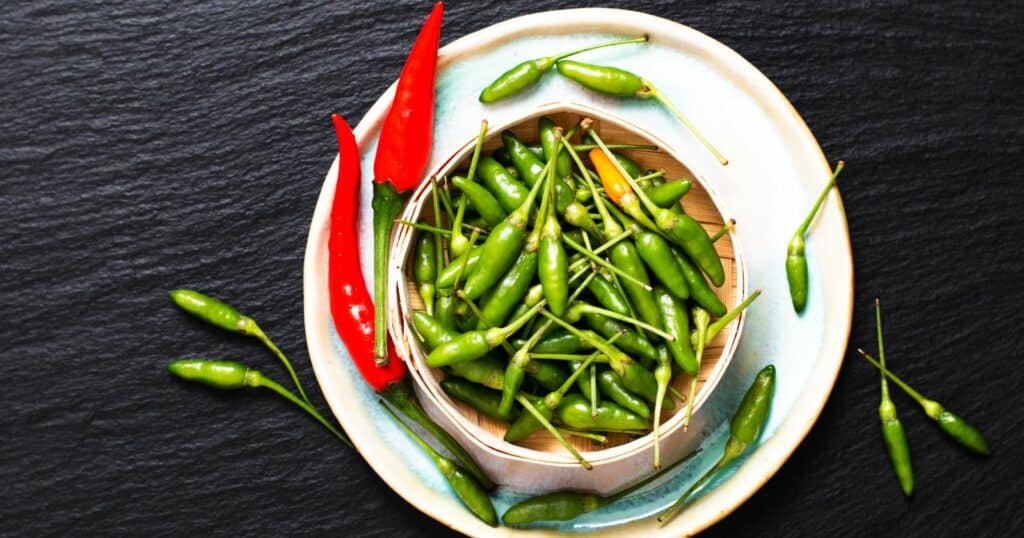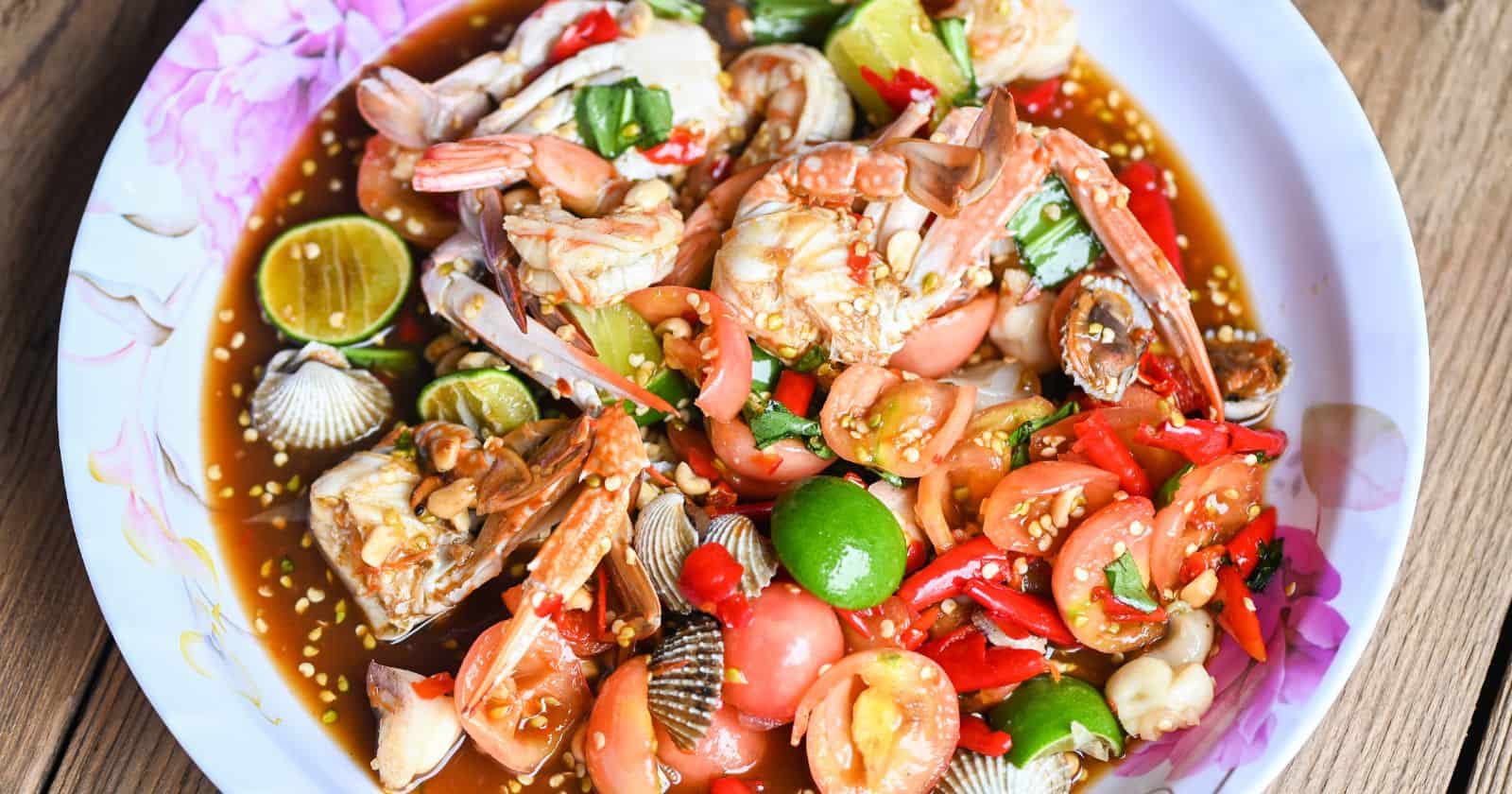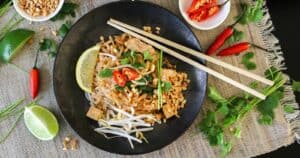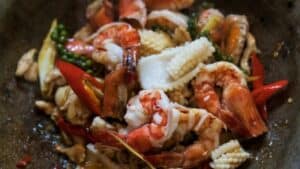Thai cuisine is renowned worldwide for its addictively bold, spicy flavors. But if you’ve ever eaten a mouth-searing Thai curry, you’ve probably wondered: what makes this food so darn spicy?
As it turns out, there are several fascinating factors behind the fiery heat of Thai food:
- Thailand’s hot, tropical climate encourages liberal use of chilies and spices, which add
spice and prevent food spoilage. - Chili peppers, especially the small but potent bird’s eye chili, provide essential spicy flavor in Thai cooking.
- Complex layers of diverse spices, herbs and sauces create Thai food’s unique symphony of tastes.
- Fusion with Indian and Chinese culinary traditions added more spices and punchy flavors.
- And yet, Thai chefs also excel at balancing spicy flavors with cooling, creamy ingredients to make milder dishes.
Curious to learn more? Read on as we uncover all the secrets behind the addictive spicy flavors of Thai cuisine!
The Spicy Influence of Thailand’s Hot, Humid Climate
One major factor behind why Thai food is so spicy is the tropical climate in Thailand. The hot, humid conditions are ideal for bacteria growth that can spoil food.
To prevent this, Thai cooks rely heavily on spices and chilies. The spicy heat of these ingredients helps preserve foods in the steamy environment.
In addition, the abundant chili peppers used in Thai cuisine contain capsaicin. This natural chemical triggers that intense, mouth-burning “spice” we associate with Thai food.
Regional Climate Differences Lead to Varying Spiciness
The climate across Thailand varies by region. This affects the typical spiciness levels and taste profiles of local cuisines:
- Southern Thailand – Known for intense spiciness. The local preference is for a slow, lasting burn from black pepper and chilies. The hot, humid climate likely amplifies the heat.
- Southwestern Thailand – Uses lots of coconut milk to balance spiciness. The tropical climate supports ample coconut growth, which adds a subtle sweetness.
- All regions – Thai food balances spicy with salty, sweet, sour and bitter. Local climates influence the use of aromatics like lime leaves, which complement spiciness.
So the next time you savor perfectly balanced Thai flavors, you can thank the climate!
Chili Peppers: The Spicy Heart of Thai Cuisine

Another huge factor behind what makes Thai food spicy is the beloved chili pepper. No other ingredient defines the Thai culinary identity quite like it. Here’s why chilies play such a vital role:
Flavor Enhancement
Thai chilies provide a quintessential spicy kick and depth of flavor. The unique taste they impart is essential in countless Thai staples. Chilies add an exciting, tantalizing element that makes Thai food internationally craved.
Balance of All Flavors
In Thai cuisine, no flavor stands alone. Chilies provide the necessary spicy component to harmonize with sweet, salty, sour and bitter notes. This creates a perfectly orchestrated symphony of tastes.
Cultural Tradition
Originally from the Americas, chili peppers were introduced to Thailand around the 16th century. They quickly became integral to Thai cooking. Today they represent centuries of culinary heritage.
In addition to flavor, chili peppers offer health perks like improved digestion and metabolism. Their versatility, with many varieties and heat levels, allows Thai chefs to fine-tune
Complex Layering of Diverse Spices and Sauces
Another secret behind why Thai food is so spicy is the complex blending of diverse spices and sauces. These ingredients elevate Thai food’s flavor dimension to an art form:
Spices like lemongrass, chilies, coriander, and lime leaves each add unique aroma and taste.
Sauces like fish sauce, oyster sauce, tamarind, and palm sugar contribute salty, sweet, sour and savory notes.
Combined skillfully, these components create Thai cuisine’s harmonious symphony of tastes. Spices and sauces build layered complexity while balancing refreshing and fiery flavors.
Fusion of Indian and Chinese Spice Influences
Thai cuisine also shows fascinating fusion of Indian and Chinese
- Ingredients – Indian vegetables and spices meet punchy Chinese sauces, combining the familiar with the exotic.
- History – Chinese immigrants in India adapted traditional dishes by incorporating local spices and ingredients. This gave birth to a wonderful blended cuisine.
- Spices – Indian spices like cumin, coriander, and turmeric add warmth and richness to Chinese cooking basics.
The melding of these two great culinary traditions produced an amazing new style bursting with flavor, complexity, and appeal.
Mildly Spicy and Balanced Dishes for Every Taste
For those who find Thai food too spicy, don’t despair! Thai chefs skillfully create many mild, balanced dishes with near-universal appeal:
- Som Tam (Green Papaya Salad) – Shredded papaya, tomatoes, peanuts, and lime-chili dressing. Easily adjusted for desired
spice level. - Tom Kha Gai (Coconut Soup) – Chicken and mushrooms simmered in coconut milk, galangal and lemongrass. Soothing and mild.
- Pad See Ew (Stir-Fried Noodles) – Broad noodles with soy sauce, vegetables and meat/tofu. A balanced, mildly spicy crowd-pleaser.
With a wide range of heat levels, every diner can find pleasing Thai dishes. The key flavors of spicy, salty, sour and sweet are artfully combined for gentle or intense
The Nuanced Heat of Thai Chilies
Not all spicy chilies are created equal! Thai bird’s eye chilies and other peppers provide a complex, multilayered heat that’s distinct from other fiery cuisines.
- Smaller Thai chilies concentrate high amounts of capsaicin oil on less surface area, leading to intense, penetrating
spice . - Thai chilies also contain unique flavor compounds like citrus and smoke, preventing one-dimensional heat.
- Multiple types of small chilies are combined for layered complexity, like mixing paint colors on an artist’s palette.
So next time you bite into a Thai curry, appreciate the nuanced symphony of flavors from those tiny but powerful peppers!
How to Adjust Spiciness When Cooking Thai Food
Hopefully this article gave you insight into what makes Thai food so spicy. But if you find some dishes too hot for your taste, don’t worry! With a few easy tweaks, you can adjust spiciness to your comfort level:
- Add dairy – Ingredients like yogurt, sour cream or cheese can help tame the heat.
- Build tolerance gradually – Getting used to spicy food takes time. Pace yourself.
- Balance with acid – A splash of lime, vinegar or other sour flavors counters spiciness.
- Sweeten it – A touch of sugar balances out chili burn.
- Specify
spice level – Many Thai restaurants let you choose mild, medium or spicy. - Use less chili – Reduce the amount of peppers or
spice pastes in a recipe.
With these handy tips, you can savor all the complex flavors of Thai food without getting burned!
Balancing Sweet, Salty, Sour and Bitter
In Thai cooking, no flavor soloists – only harmony. Spicy heat is carefully balanced by sweet, salty, bitter and sour tastes.
- Sweetness from palm sugar, coconut milk or fruits cools the palate between bites of heat.
- Sour notes from lime, tamarind or vinegar provide tangy counterpoint to chilies.
- Bitter flavors from ingredients like bitter melon balance the intensity.
- Salt enhances and unifies the overall taste experience.
This thoughtful balance allows you to appreciate each complex flavor even in very spicy Thai dishes.





